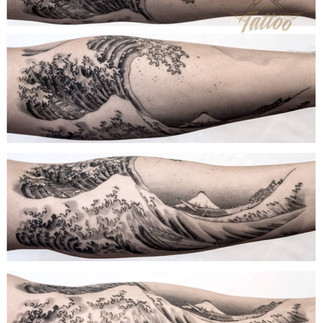Mixing Styles with Japanese Traditional Tattoos
- May 11, 2023
- 4 min read
Table of Contents
Japanese traditional tattoos remain one of the original and most recognizable forms of tattoo styles on the planet. This style of tattoo is extremely iconic due to its distinct imagery that tackles relevant images to Japanese culture. The pinnacle of stereotypical Japanese traditional tattoo imagery includes dragons, koi fish, traditional Japanese masks, and samurai. Beyond just the distinct imagery, Japanese traditional pieces are also known for their extremely detailed line work paired with vibrant, saturated color, which infuses the piece with life.
While Japanese traditional tattoos can stand excellently on their own due to the intense color and detailed lines, sometimes the basic style of any tattoo just isn’t enough. In this guide, we will approach the situation of mixing tattoo styles with Japanese traditional to take an original style of tattoo and spice it up by mixing in new features. With proper planning, you can easily mix together two different tattoo styles with tremendous success. Below, we’ll answer the question as to how one goes about mixing their tattoo styles before naming some examples of styles that work well with a Japanese traditional piece.
Mixing Styles
In general, when mixing two different tattoo styles together, there are two lanes to approach the problem. First, there is mixing by proximity. This method is used in instances where you want to mix a tattoo that has previously been inked on skin. For this method, you and the artist will work together to design a tattoo that can fit and look nice next to a pre-existing piece. This typically puts more pressure on the new design to adapt and morph around the details of the original piece. With that being said, this method also is a fantastic way to breathe new life into an old tattoo!
The second method for mixing two different tattoo styles together is so-called mixing by design. As the name suggests, when you mix by design, you and your artist will work together to design two tattoos at the same time that will work together, but follow different rules. Arguably the more flexible of the two, there are almost endless possibilities when the mixing of tattoo styles occurs during the design phase.
Mixing Styles with Japanese Traditional
While you can produce incredible imagery through the mixing of tattoo styles, not all styles can effectively mix together. Sometimes, the regulations surrounding different tattoo styles will clash and take away from the individual tattoos. This is why planning is key; not all styles and images work together. Let’s dive into some examples of ideal tattoo styles to mix with a Japanese traditional piece.
Black and Grey
Black and grey is a tremendously flexible tattoo style that often works well mixed with many other styles. Japanese traditional is no exception; the detailed line work and thick lines that can be found in black and grey pieces can play off of a detailed, saturated Japanese traditional piece. However, when mixing these two styles, one should put emphasis on thicker lines and shading with the black and grey piece. Fine line pieces, which are similar to black and gray, but are typically smaller and finer, are often dominated by the larger size and deeper color of a Japanese traditional piece. Thus, when combining these two styles, make sure that the black and grey aspect of the piece is bold and can be seen,
Color Realism
As mentioned, fine line tattoos may struggle to be seen and stand out in the shadow of a Japanese traditional piece filled with dark lines and deep color. Color realism pieces tend to not share this downside to fine line; color realism pieces are often large with deep color and detailed lines themselves, which lends itself towards being able to readily mix with Japanese traditional. These styles individually are typically rather large, which helps them stand on equal footing when placed near each other. This works well for the final product, although the large space required to effectively mix these two styles together definitely takes some forethought and planning.
Abstract
The unique nature of abstract tattoos makes them rather adaptable to the tattoo mixing process. The variety of images and colors available in an abstract piece can blend and play off certain Japanese traditional pieces with good success. Similar to black and gray, the flexibility of this style lends itself towards being additive to an already placed or already designed Japanese traditional piece. The Japanese traditional aspect will follow more regulations giving less freedom to how you can manipulate the piece. Abstract, on the other hand, can be readily changed and squished and morphed to adapt and fit around the previous design.
Contact First Class Tattoo in NYC Today!
Regardless of the styles you want to mix and the method of mixing you wish to tackle, having an experienced artist at your side to help guide you towards a final product that will look fantastic is essential. The artists at First Class Tattoo in New York City are exactly that. With years of experience in the tattoo industry, our artists know what styles work together and what styles are best left separate. We are more than willing to sit down and flesh out the details to your awesome idea! Plus, once the design phase is over, our expert artists will masterfully apply your design and transform your body with some awesome ink. Don’t wait, contact First Class Tattoo today to get started!

























